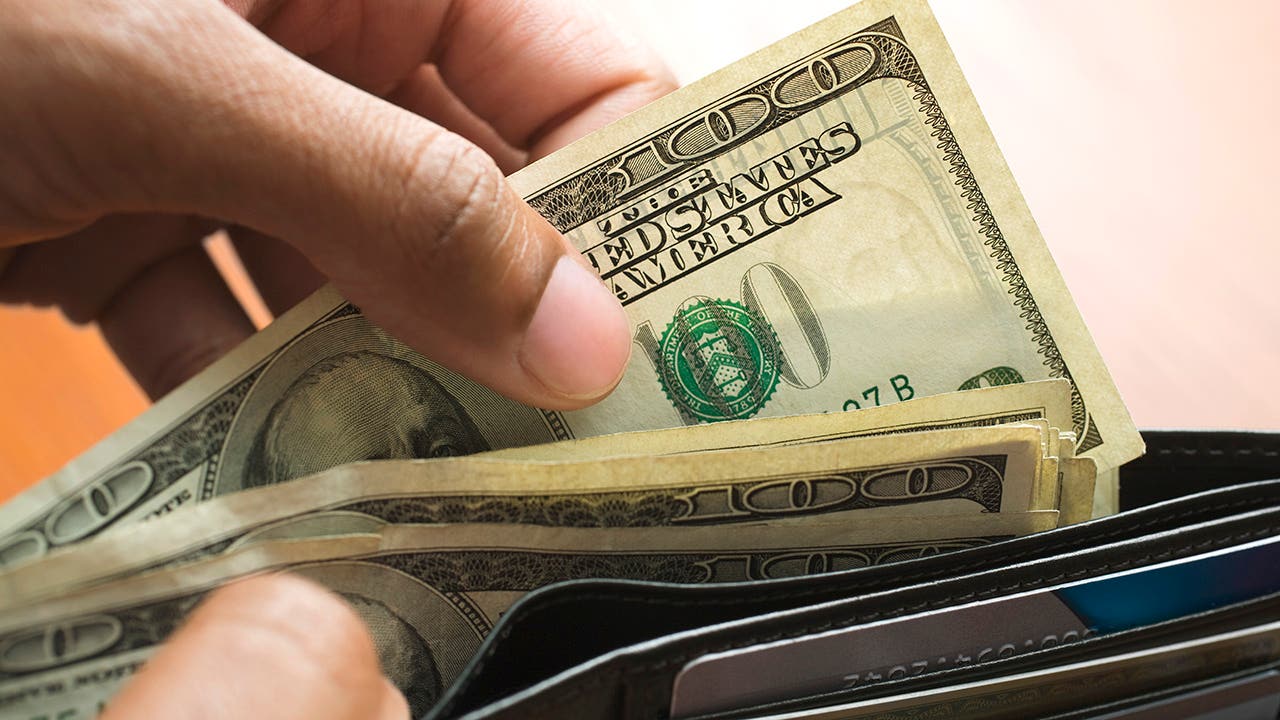10 ways to save $100 more each month

The Bankrate promise
At Bankrate we strive to help you make smarter financial decisions. While we adhere to strict , this post may contain references to products from our partners. Here's an explanation for .
Struggling to save money right now? You’re not alone. More than half (57 percent) of U.S. adults surveyed in Bankrate’ most recent emergency savings report said they’re uncomfortable with their level of savings. Furthermore, 22 percent say they have no emergency savings at all.
There are, however, some steps you can take to save a little bit more each month. Saving just $100 more a month would amount to accumulating a $1,200 emergency fund after a year. You can easily achieve this by making a few small changes across different categories of your budget and daily spending habits. Here are 10 ways to do so.
1. Avoid bank fees
Bank fees are sure to eat into your balance if you don’t look out for them. The average overdraft fee is currently $26.61, according to Bankrate’s latest checking account survey, and the average combined out-of-network ATM fee per transaction is $4.73.
One easy way to avoid fees, especially overdraft fees, is to set up mobile bank alerts. Many mobile banking apps come with the option to turn on alerts for when your account falls below a certain balance or is at risk of an overdraft. If mobile alerts aren’t an option, make sure to check your balance regularly or opt-out of overdraft coverage.
When it comes to ATM fees, you can largely avoid these by sticking to in-network ATMs. Your bank’s mobile app may come with an ATM locator, or you may search for nearby ATMs on the bank’s website. Alternatively, you can frequently get cash back for no fee when you check out at retail or grocery stores.
Some other fees to look out for include monthly maintenance fees, money transfer fees and fees for not meeting the minimum balance requirement. Many bank accounts don’t charge fees though, so it might be worth considering opening one of these accounts instead.
2. Find a higher-yielding savings account
While many large, traditional banks are still only offering a fraction of a percentage for yields on savings accounts, some of the best savings accounts on the market have annual percentage yields (APYs) of around 5 percent.
It might not make a huge difference at first, but over time, earning a higher yield on your savings can be highly rewarding. Suppose you have $10,000 in savings. At Bank of America, for example, the interest rate on a standard savings account as of September 2023 is a mere 0.01 percent. In this case, in one year you’d earn only $1 in interest.
Meanwhile, if you put that savings into an account with a 5 percent APY, you’d earn a whopping 500 times that, or $500 in a year. As you contribute more to your savings, those earnings will continue to increase much more than they would with an account with a lower APY.
Many of the highest APYs are offered by online banks. Online banks have lower overhead costs compared with traditional institutions with brick-and-mortar branches, so they can offer higher rates, which in turn helps them grow their deposits base. If you’re comfortable with online banking, it could be a good idea to look into online savings accounts, which often also come with low or no fees.
3. Curb impulse buying
We’ve all indulged ourselves in impulse purchases here and there. We’ve also all had regrets about purchases we didn’t need but made anyway.
There’s no use in trying to avoid buying anything that’s not totally necessary, but there are a few simple tricks to help you withhold from making some of those unnecessary purchases (and have a bit more to save each month).
One obvious, yet effective, tip is making a shopping list before going shopping. By doing so, you stick to a spending plan that aligns with your budget. If you stick to the list, you can prevent giving in to temptations and avoid overspending while shopping.
Another easy tip is to write down the item you want to buy and wait a few days or even a week before making the purchase. If you still want the item after that time, you can buy it, but if you find that your desire to buy was fleeting, you can save what you would have otherwise spent on that purchase.
4. Cut down on energy consumption
Reducing your energy consumption has the benefit of not only reducing your bills but also helping the planet. By taking some steps to limit consumption of electricity and other utilities, you could save up to 25 percent on utility bills, according to the U.S. Department of Energy.
The Office of Sustainability at Harvard University suggests five top ways to reduce electricity consumption:
- Turn off your computer monitor at night, as opposed to leaving on a screensaver.
- Switch to LED lightbulbs — they use 75 percent less energy than incandescent bulbs.
- Unplug electronics, including televisions, microwaves and printers, when they’re not in use. Leaving electronics plugged in when they’re switched off could add 10 percent more to your utility bill, according to the U.S. Department of Energy.
- Use a power strip to easily turn off multiple devices at once.
- Turn off lights when they’re not needed.
The U.S. Department of Energy also notes that heating and cooling account for a large portion of energy costs. You can save between 7 percent and 16 percent annually in water heating costs by insulating your water tank, and turning your thermostat down a few degrees during the day in colder months can save you as much as 10 percent annually.
5. Set up auto-pay on bills
Another way to save money on bills is to set up automatic payments, often called auto-pay. Many billing services allow you to set up auto-pay online. Doing so can ensure you don’t miss any bill payments (and therefore aren’t charged late fees), and it usually comes with a discount. Loan servicers, for example, may lower your interest rate if you opt for auto-pay.
Check your account balance regularly so that it isn’t overdrawn by an automatic bill payment, or set up auto-pay with an account that you know won’t be charged an overdraft fee.
6. Get a coffee maker
If you’re a regular coffee drinker, you can save a lot by making coffee at home instead of buying it from a café. A home coffee maker can cost anywhere from $50 to a few hundred dollars, but making this purchase can save you a lot in the long run.
Let’s say, for example, you spend $4 on coffee, five days a week. That would be over $1,000 spent on coffee in a year. Meanwhile, the average cup of coffee brewed at home would cost you $0.74, according to a study by MyFriendsCoffee. Multiply that five times a week for a year and that’ll cost you around $190, resulting in a savings of more than $800 annually. Realistically, you might still go out to a café for coffee now and then, but you’d still be saving a lot overall.
7. Consolidate streaming subscriptions
Cable television can easily cost you more than $100 each month. Meanwhile, most popular streaming services will cost you $15 or less. For example, Max has individual plans starting at $9.99 a month, while Netflix’s individual plans start at $6.99 a month. Consider picking out one or two of your favorite streaming services to reduce your entertainment spending.
Moreover, many streaming services have premium options that allow multiple screens in a household to use the service at once. If you live with roommates or a spouse, you could share a streaming subscription and pay a lower amount per person.
8. Shop around for the best deals
Becoming more conscious about what you buy can end up saving you quite a bit over the course of a month.
When grocery shopping, look for store-brand food items, which are often more inexpensive than name brands. The same applies to drugstores such as CVS and Walgreens.
If you frequently shop online, consider getting a browser extension, such as Honey or RetailMeNot. These downloadable services are free and look for the best deals on various items you’re shopping for online, sometimes even offering cash back on certain items.
9. Find the lowest gas prices
Gas prices continue to remain high. While they’ve come down somewhat since being hit hard by inflation in 2022, they’re on the rise again. But there are some easy ways you can save on gas.
First, consider signing up for an app that can find the lowest gas prices near you. GasBuddy and Waze are two popular, free apps that can do just that. With one of these apps, you can enter your current location or ZIP code and see the prices for gas stations nearby. GasBuddy even has a trip cost calculator, which estimates how much a road trip will cost you on gas.
A GasBuddy study from 2022 found that certain days of the week are less costly to fill up on gas than others. The day that has the lowest gas prices on average is Monday, followed by Friday. It might not save you that much, but with gas prices continuing to burn a hole in your pocket, buying gas on Mondays or Fridays could shave off a bit more of your gas spending for the month.
10. Pay off outstanding debts
Debt is a long-term, burdensome reality for many people. More than one-third (36 percent) of consumers say they have more credit card debt than savings, for example, according to Bankrate’s emergency savings report.
Most loans, especially credit card debts, come with interest charges that add to your monthly costs. By paying off the principal amount faster, you can reduce the amount on which interest is calculated, leading to decreased monthly interest charges over time.
While it’s a longer-term strategy, paying off debts can save you in multiple ways. Not only does it decrease your monthly costs, but it also helps improve your credit score and financial health. A better credit score can qualify you for loans and credit cards with lower interest rates. By transitioning from high-interest debts to low-interest ones, or eliminating debts entirely, you free up a significant portion of your monthly income.
Bottom line
Saving money isn’t just about having more cash in your pocket now — though that may be one goal out of several. It’s also about building a safety net for the future. By cutting down on small expenses, you might not notice big rewards right away, but the benefits will add up over time.
To make the most out of saving, keep track of how much you’ve managed to put away. Tracking your savings can be motivating, especially when you have clear savings goals in mind.
Related Articles



